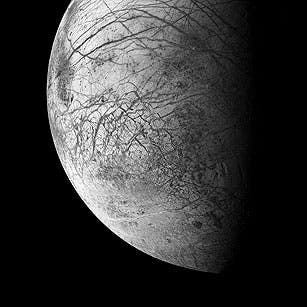Yesterday, NASA held a press briefing where scientists involved in a recently published study, of intense consequences to the scientific community, and people looking for signs of extraterestrial life alike, discussed how Jupiter’s icy satellite has great chances of fostering life in the warm oceans beneath its surface.
Europa’s surface is covered in a layer of ice tens of kilometers in thickness, which presents a scarred, fractured texture. For years scientists have been studying this peculiar surface, and recent images and data transmitted back by the Galileo spacecraft have provided countless breakthroughs.
For their study, published in the journal Nature, scientists studied ice shelves in Antarctica, as well as underwater volcanoes and used them to model what happens millions of miles away in Europa. The researchers found that under Jupiter’s moon surface a complex array of underground warm lakes lye, sprung up by warm current from the oceans beneath (thought to be as 100 miles deep), which are responsible for the collapse of these roughly circular structures above them. Upwelling of warmer water causes melting of surface ice, forming cracks; then frozen water gets trapped between the cracks, cementing the new glacier. The underside then freezes again, which causes the uplifting
The presence of shallow lakes underneath Europa, which are believed to be underneath 50% of the moon’s surface, means that the surface waters are mixing up with deep water, allowing for a transfer of nutrients in the process.
“That could make Europa and its ocean more habitable,” said lead author Britney Schmidt from the University of Texas at Austin, US, who analysed images collect by the Galileo spacecraft launched in 1989.
Liquid water is a must have prerequisite for sustaining life, but to harbor life you indispensably also need energy. The sun’s rays have supported life for billions of years on Earth, but what about underneath Europa’s surface where a plunge of darkness reigns supreme? Well, spacecraft observations show that there is a huge amount of stored energy in Europa’s mineral-rich crust, but it is separated from the liquid ocean below by at least 6 miles (10 km) of ice.
“What you’re hearing about here today would be a way to take this surface material, transport it potentially down into the ocean and in essence tap Europa’s battery. When you tap that battery, you move from a system which checks one of the requirements for life to a system that checks a second critical requirement for life, and I think this really impacts the way we consider habitability on Europa,” said Astrobiologist Tori Hoehler, a senior research scientist at NASA’s Ames Research Center in Moffett Field, Calif., who was not involved in the new study.
Water and energy, two prerequisities for life already on board on Europa, which makes a highly enchanting prospect for life, but nothing can be known for sure until the first sample will be one day analyzed.
UPDATE: A team of researchers from the US have drilled through hundreds of meters of Antarctic ice and found evidence of life in a subglacial lake, isolated from the outside world for maybe millions of years. If life could survive there, isolated and thus presumably devoid of oxygen and nutrients, then microbial life might just as well survive in similar environments outside Earth – like our own icy moon of Europa.










